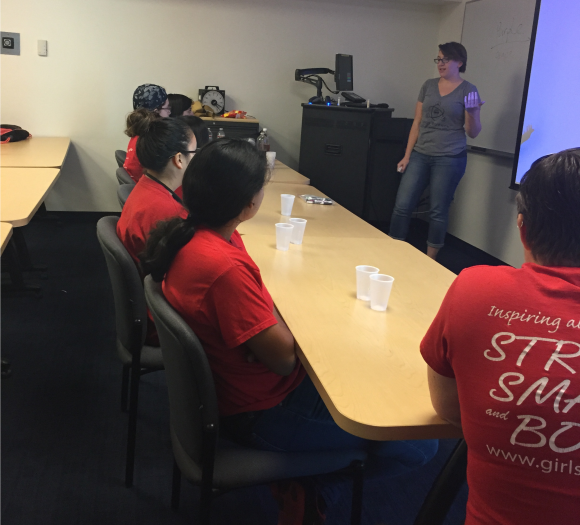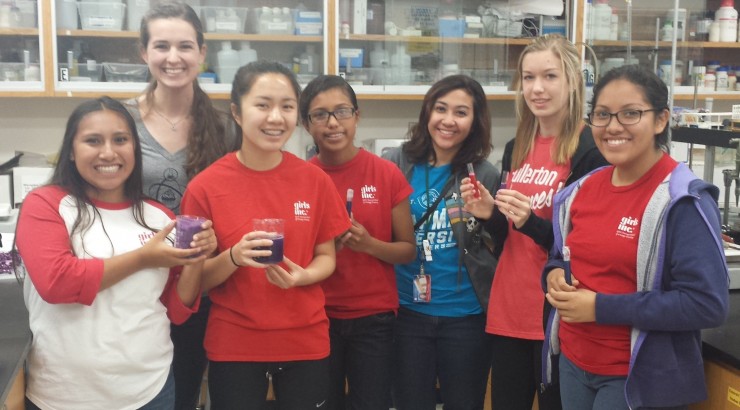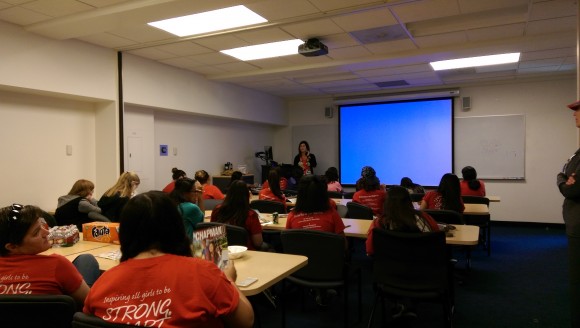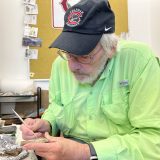FOODucation: A Workshop for Girls Inc!
April 19, 2015
On Saturday April 11th, Chapman’s Food Science Program had the pleasure of hosting an interactive educational experience for Girls Inc!

Emma Gottschall explains concepts in sensory science
High school students from different regions of Orange County were brought to Chapman University to learn about Food Science, thanks to the collaboration between FSNSA and Girls Inc. female leaders Christie Pearce, Amanda Perl and Cathleen Chase.
The students were actively engaged in all aspects of the event that included an information session on college admission, a campus tour, and presentations from our very own food science graduate students. It was great to see how excited the students were to learn about scientific principles behind ice cream, evaluating our taste perception and making gummy balls! In addition, students asked insightful questions to gain a deeper understanding of the science as well as the admission application process.
I have no doubt these young women will become successful professionals in any career they choose!
Sensory Demonstration

Sabrina Davis, Katrina Jully and students from Girls Inc posing with anthocyanin extracts from red cabbage
The demo led by FSNSA member
Emma Gottschall
focused on sensory science. Students were first asked to try two samples of colored seltzer, one purple and one pink. Without any hints about the flavors, most girls believed the purple sample tasted like grape, while there was a mixed consensus about the pink drink. Students were surprised to learn that the purple juice was actually strawberry-kiwi!
While most people assume that taste is the only impact on how we perceive flavor, students learned that your expectations also have a huge impact on how a food tastes. While some attributes like color or size can be controlled in sensory testing, other factors cannot be controlled.
Emma took the demonstration one step further to help students understand the role of genetics in taste. Participants were given PTC strips containing phenylthiocarbamide. When tasting PTC, approximately 75% of the population perceive a highly bitter taste based on a specific gene. The remainder of the population perceive a slight bitter taste or none at all. Emma said “The girls were extremely interested in learning about the science behind sensory testing as well as what it’s like to be a taste tester. After all, who wouldn’t love to get paid to eat?!”

Akanksha Jain explains gel network formation with assistance from Logan Kane as a “calcium ion”
Pigment Demonstration
Another demo was led by
Sabrina Davis
and focused on pigments from red cabbage. Sabrina said “The girls enjoyed seeing the changing colors of cabbage extract, from purple to red and from red to blue!”
Extracts from the cabbage can be used as a pH indicator. The pigment that gives the vegetable its color is called anthocyanin which undergoes a color change under acidic and basic conditions. The demo showed the process of extraction of the cabbage pigments, as well as the solutions that change its color!
Gummies Demonstration
In third demo
Akanksha Jain
educated students on how aliginate, a substance from algae, can be used to form gummies! In the photo above, Logan Kane represents a “calcium ion” which is required for the alginate to form a gel network and produce a gummy!

Top right: Emma Gottschall pouring liquid nitrogen into ice cream base. Bottom: Students add color to their ice cream
Ice Cream Demonstration
One of the tastiest demonstrations was led by
Charles Quinto
and focused on ice cream! Ice cream is considered an oil-in-water emulsion, which means that the product is made up of tiny particles of water distributed in oil. The oil is from the different fats present in the ice cream base from the milk component.
Ice cream is also considered a foam as air is whipped into the ice cream causing an increase in volume. The process of whipping the ice cream base to increase volume is known as overrun. In the food industry, ice cream has a maximum allowed percentage of being 100% overrun – or allowing a twofold increase in volume.
Large ice crystals in ice cream produce a texture that is icy and unpleasant when the expectation is a creamy product. To prevent the formation of large ice crystals, we used liquid nitrogen to rapidly freeze the ice cream base. This quick freezing action prevents large ice crystal formation and therefore produces a nice creamy ice cream!
In the pictures above, Emma is carefully adding liquid nitrogen while whipping the ice cream base (dressed in proper protective equipment – safety first!) while students get to decorate their ice cream with food coloring and sprinkles!
As the eventful day came to a close, the girls heard from a representative of Chapman to learn about the application process, majors offered and how standardized testing scores are used. After learning about what it takes to get into Chapman, students were given a tour around campus before heading back home with newfound knowledge in Food Science!
Full Circle
It was also great to see that a current FSNSA volunteer,
Katrina Jully
, could personally relate to Girls Inc.
“I had the opportunity to be a part of Girls Inc. back when I was in middle school. So for me to be a part of it again, but as a team leader, was a wonderful way to complete the circle. I am so glad to see that Girls Inc has grown over the years and continues to be a wonderful organization that supports the development of girls into strong, bold, and confident women.”
It was a great event and we look forward to continuing the tradition of educating young minds!
If you want to know more about the chemistry behind these experiments, or just food science in general, follow our blog, e-mail the Food Science Program Assistant Sonja Montiel (
smontiel@chapman.edu
), or join the Food Science and Student Nutrition Association (FSNSA)!
Written by Charles Quinto, President of FSNSA



